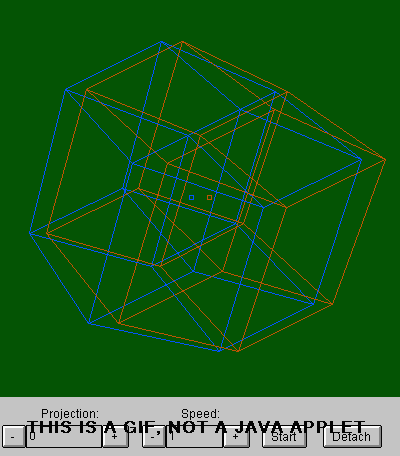Credit & Copyright: Mark Newbold
Explanation:
Does our universe have
higher but unusual
spatial dimensions?
This idea has been gaining popularity to help explain why vastly separated parts of our universe appear so similar,
and why the geometry of our universe does not seem to result naturally from the
amounts of matter it seems to contain.
In a
new incarnation of an old
extra-dimensional idea, some astrophysicists
hypothesize that we live in a universe dubbed Ekpyrotic,
where our four dimensions
(three spatial plus one time) resulted
from the fiery collision of two four-dimensional spaces
(branes) in a
five-dimensional universe.
This big-bang hypothesis is meant to compete with another big-bang hypothesis
that our universe underwent a
superluminal inflation event in the distant past, and does make distinct testable
predictions.
Above, a dynamic three-dimensional drawing (two spatial plus one time) of a
four-dimensional depiction of a five-dimensional cube (a hypercube with four spatial dimensions is also known as a
tesseract) is shown.
Donning red-blue glasses will give the best
multi-dimensional perspective.
1999 2000 2001 2002 2003 2004 2005 2006 2007 2008 2009 2010 2011 2012 2013 2014 2015 2016 2017 2018 2019 2020 2021 2022 2023 2024 2025 |
Январь Февраль Март Апрель Май Июнь Июль Август Сентябрь Октябрь Ноябрь Декабрь |
NASA Web Site Statements, Warnings, and Disclaimers
NASA Official: Jay Norris. Specific rights apply.
A service of: LHEA at NASA / GSFC
& Michigan Tech. U.
|
Публикации с ключевыми словами:
ekpyrotic universe - hypercube - tesseract - тессеральный - многомерное пространство
Публикации со словами: ekpyrotic universe - hypercube - tesseract - тессеральный - многомерное пространство | |
|
См. также:
| |
